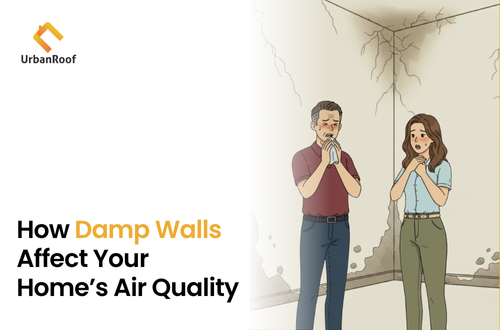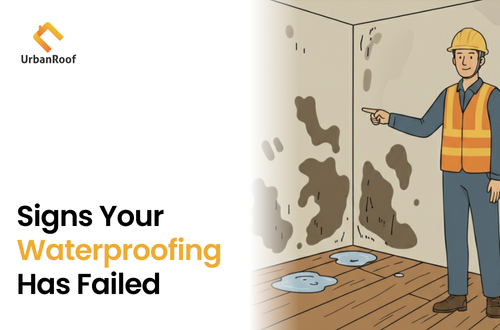How Damp Walls Affect Your Home’s Air Quality
The Hidden Connection Between Wall Dampness and the Air You Breathe
You might notice peeling paint, musty smells, or dark patches on your walls — but what you can’t see is how damp walls silently pollute the air inside your home. In Indian homes, where humidity and monsoons are common, this problem is often underestimated. Wall dampness isn’t just a structural issue; it directly impacts the air quality, health, and comfort of your living space.
At UrbanRoof, we’ve seen how untreated dampness not only damages interiors but also creates an unhealthy indoor environment. Let’s understand how this happens and what you can do to fix it.
1. Damp Walls Lead to Mould and Fungal Growth
When moisture remains trapped in walls, it creates the perfect breeding ground for mould, mildew, and fungi. These microorganisms release microscopic spores into the air, which can trigger allergies, respiratory issues, and even long-term health problems.
Common signs of mould-affected walls include:
- Black, green, or white fuzzy patches
- Persistent musty odour
- Sneezing or coughing that worsens indoors
UrbanRoof Insight: In our inspections, 7 out of 10 damp homes show high mould concentration, especially behind furniture or near bathrooms.
2. Moisture Increases Indoor Humidity Levels
Damp walls continuously release water vapour into the air, raising the overall indoor humidity. High humidity not only makes rooms feel stuffy but also encourages dust mites and other allergens to thrive.
Prolonged exposure to humid air can:
- Cause discomfort and fatigue
- Damage wooden furniture and metal fixtures
- Promote condensation on windows and walls
To maintain healthy air quality, indoor humidity should ideally stay between 40% and 60% — a balance that’s impossible when walls stay damp year-round.
3. Unpleasant Odours from Microbial Growth
That “damp smell” in many Indian homes is caused by volatile organic compounds (VOCs) released by mould and bacteria growing inside walls. These odours are not just unpleasant — they’re signs of biological contamination.
Over time, VOC exposure can cause:
- Headaches or dizziness
- Throat and eye irritation
- General discomfort and poor sleep quality
Using air fresheners only masks the smell; eliminating the root cause — wall dampness — is the real solution.
4. Dust and Pollutants Stick More to Moist Surfaces
Moisture turns wall surfaces slightly sticky, allowing dust, dirt, and air pollutants to cling more easily. This worsens indoor air pollution, especially in urban areas where airborne particles from traffic and construction are already high.
As these particles settle on damp walls, they create dark patches and unhealthy air pockets within enclosed spaces.
UrbanRoof Tip: Repainting over damp walls traps moisture further, worsening both appearance and air quality. Always repair dampness before any cosmetic fixes.
5. Long-Term Health Effects
Poor indoor air quality caused by damp walls can lead to chronic respiratory conditions, allergies, and fatigue — particularly for children and elderly family members. Continuous exposure may also weaken immunity and worsen asthma symptoms.
Doctors often report that patients’ symptoms improve when they move away from damp environments, highlighting the clear health connection between moisture and air quality.
How UrbanRoof Solves Dampness to Improve Air Quality
At UrbanRoof, we go beyond just treating the surface. Our dampness inspection process includes:
- Thermal and Moisture Scanning to find hidden leaks
- Source Identification to locate seepage paths
- Waterproofing and Wall Restoration to permanently block moisture
- Post-Treatment Air Quality Check to ensure a healthy indoor environment
By fixing the root cause, we not only dry out your walls but also help restore clean, breathable air inside your home.
Final Thoughts
Damp walls silently degrade your home’s air quality — affecting both health and comfort. If you notice persistent humidity, odours, or visible mould, it’s time to take action.
A one-time inspection by UrbanRoof’s waterproofing experts can help identify moisture sources early and protect both your home and your health.
Remember, a dry wall means cleaner air — and a healthier home for your family.




